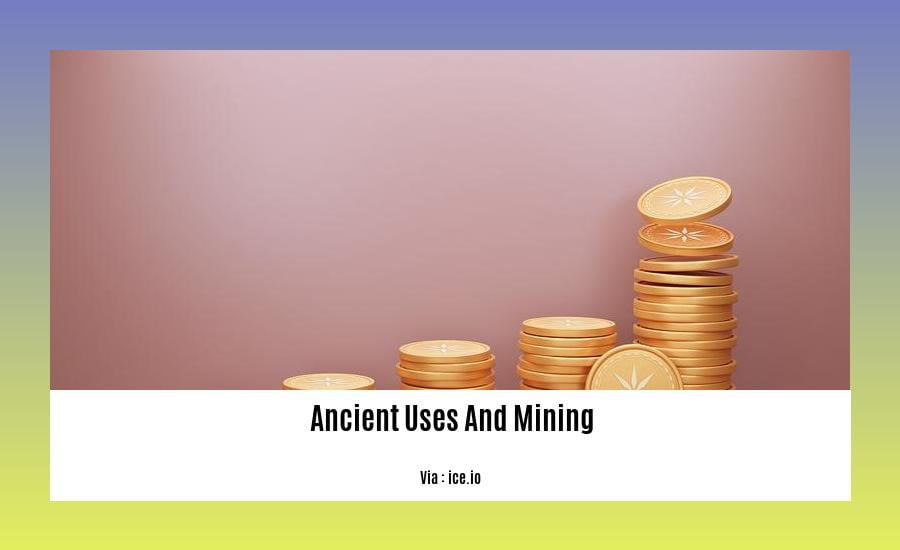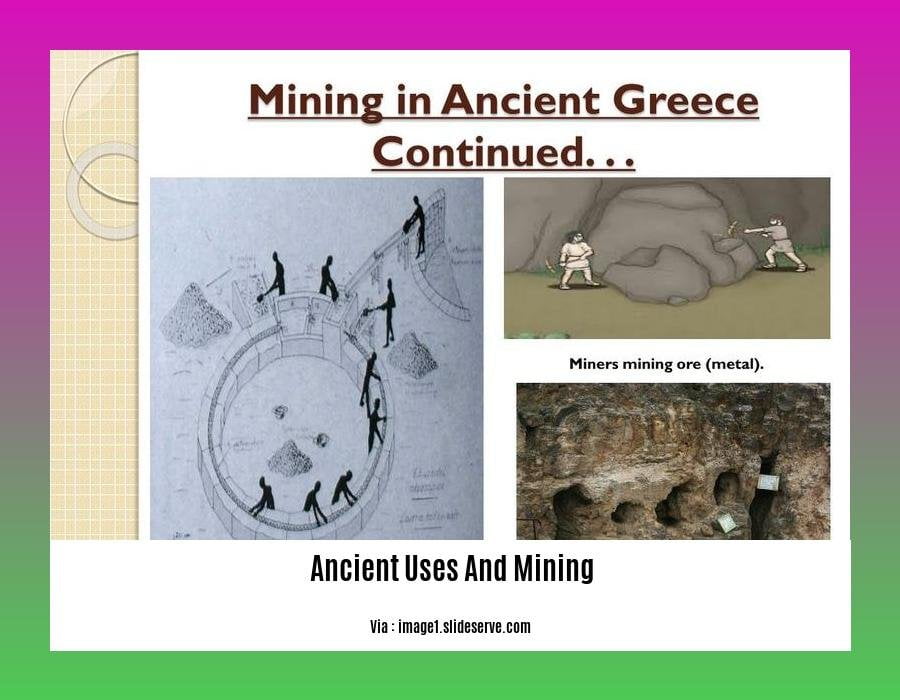Delve into the fascinating world of ancient mining practices and discover how civilizations throughout history extracted valuable resources to shape their societies and technological advancements. From the copper mines of the ancient Egyptians to the gold-rich hills of the Incas, we will explore the techniques and technologies used to unearth the Earth’s hidden treasures, and examine their profound impact on the development of human civilization: The Ancient Uses and Mining Practices of Civilizations Past.
Key Takeaways:
- Ancient Mining Practices: Involved extracting minerals and resources from the earth, primarily for jewelry, tools, and currency.
- Methods: Hydraulic mining, shaft mining, and Archimedes screws.
- Roman Empire: Prolific in mining, developed advanced metal extraction techniques.
- Ancient China: Produced a wide range of metals, including gold, silver, and iron.
- Early Mining Tools: Picks and hammer stones (Stone Age).
- Sought Materials: Precious and utilitarian metals (e.g., gold, silver, iron, copper).
Ancient Uses and Mining

Let’s explore the ancient uses and mining practices that shaped human civilization.
Mining has been around for millennia, with humans extracting precious metals and resources from the earth for various purposes.
Ancient Mining Methods
In ancient times, miners used hydraulic mining and shaft mining techniques to access minerals. These processes often involved channeling water to erode soil and expose mineral deposits or digging deep shafts into the earth. Advanced techniques, like Archimedes screws, were also employed to remove water from mines.
Mining in the Roman Empire
The Roman Empire was a mining powerhouse, extracting a vast array of metals, including gold, silver, iron, and copper. They developed sophisticated mining techniques, such as hydraulic fracturing, to enhance efficiency.
Ancient China’s Mining Legacy
Ancient China was a prolific producer of gold, silver, copper, iron, and other metals. They used both open-pit and underground mining methods and developed innovative techniques for refining and casting metals.
Early Mining Tools
Initially, miners used simple tools like picks and hammer stones. As technology progressed, specialized tools were developed, such as chisels, wedges, and drills.
Sought-After Materials
Precious metals like gold and silver were highly prized for jewelry and currency. Utilitarian metals such as iron, copper, tin, and lead were essential for tools, weapons, and construction.
Remember, the ancient uses and mining practices laid the foundation for modern extractive industries. They provide insights into the ingenuity and resourcefulness of our ancestors.
Did you know that the history of gold goes back far beyond the first gold coins minted in the early 6th century BC? To broaden your knowledge about gold, its historical significance, and its role in the global economy, click on the links below and explore our comprehensive articles on these topics:
<history of gold:>
<gold rushes:>
Environmental Impact of Ancient Mining

In ancient times, mining practices left a significant environmental impact. Here’s how:
Pollution
Mining releases mineral matter into the atmosphere, polluting the air and soil. Romans extracting silver in Spain and Portugal spewed copious amounts of lead into the environment.
Soil Contamination
Metals such as copper, silver, lead, mercury, and zinc contaminate the soil near mining sites. These contaminants can persist for centuries, potentially harming ecosystems.
Landscape Damage
Mining activities reshape landscapes. Open-pit mines and mining waste alter ecosystems and disrupt natural habitats.
Key Takeaways:
- Mining activities released pollutants into the environment, leading to air and soil contamination.
- Soil near mining sites became polluted with heavy metals, impacting ecosystems.
- Mining operations altered landscapes, affecting habitats and ecosystems.
Relevant Sources:
- Environmental Impact of Roman Mining and Metallurgy
- Ancient Mining and Metallurgy as the Origin of Cu, Ag, Pb, Hg, and Zn
Sociocultural and Economic Significance of Mining
The sociocultural and economic significance of mining cannot be overstated. Since the dawn of civilization, mining has played a crucial role in shaping societies and economies around the world.
Cultural Significance:
- Mining provides the raw materials to fulfill our artistic cravings, crafting beautiful objects from exquisite jewelry to monumental sculptures.
- Mining has empowered ancient cultures to leave a lasting architectural legacy. Structures like the Great Pyramids of Giza, Stonehenge, and the Colosseum are testaments to the cultural significance of mining.
Economic Significance:
- Mining fuels industries, providing essential materials for infrastructure, transportation, and technology.
- Mining generates employment and drives economic growth in both local communities and nations as a whole.
- The global mining industry employs millions of people and contributes trillions of dollars to the world economy.
Key Takeaways:
- Mining has a rich and diverse history, providing insights into past civilizations, art, and technological advancements.
- Mining played a vital role in the development of metallurgy, transportation, and architecture.
- The sociocultural and economic impact of mining has shaped civilizations throughout history.
- Mining continues to be an important industry today, providing essential raw materials and driving economic growth.
Sources:
- Mining and Quarrying in the Ancient Andes: Sociopolitical, Economic, and Symbolic Dimensions
- El Señor de los Minerales: Minería y Metalurgia en el Perú Antiguo
Case Studies of Notable Ancient Mining Sites
Unraveling the Depths of History through Archaeological Investigations
As we delve into the depths of ancient civilizations, uncovering the secrets of their mining practices offers a fascinating glimpse into the resourcefulness and ingenuity of our ancestors. Through excavations and meticulous analysis, archaeologists have unearthed a treasure trove of insights into the methods, technologies, and social implications of ancient mining. Here are some notable case studies that shed light on the rich history of this industry:
Las Médulas, Spain:
Nestled in the hills of northwestern Spain, the Las Médulas gold mine is a testament to the advanced hydraulic mining techniques employed by the Romans. The site is characterized by vast, crater-like landscapes and an intricate network of canals, reservoirs, and aqueducts. Archaeological studies have revealed the sophisticated engineering behind this mine, which enabled the Romans to extract massive quantities of gold by diverting and utilizing water for hydraulic erosion.
Spiennes, Belgium:
Located in southern Belgium, the Spiennes flint mines are among the oldest known mining sites in Europe. Excavations have uncovered a vast network of underground galleries and shafts dug out by Neolithic miners. The flint extracted from Spiennes was used to create tools, weapons, and other essential items for daily life. The site provides valuable insights into the earliest forms of mining and the role it played in shaping human societies.
Key Takeaways:
- Ancient mining practices varied significantly across civilizations and time periods.
- Archaeological techniques and methodologies play a crucial role in reconstructing past mining landscapes.
- Case studies of notable mining sites offer valuable insights into the technologies, social organization, and environmental impact of ancient mining.
Sources:
- UNESCO World Heritage Centre: Las Médulas
- UNESCO World Heritage Centre: Neolithic Flint Mines of Spiennes















